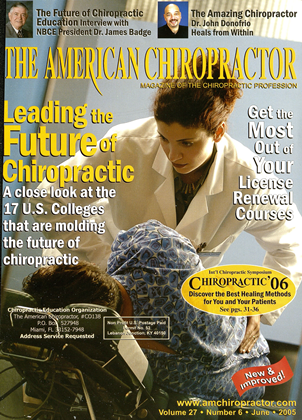P RACTICING CHIROPRACTORS ARE I-"ACEI> WITH THE CHALLENGE of determining when to adjust. Trying to apply examination procedures, such as medical orthopedic tests, which do not indicate the presence or correction of vertebral subluxations, has frustrated many doctors. The concept of nerve interference is often challenging to patients. Their confusion is compounded when the chiropractor claims to be subluxation based, but bases care on the presence or absence of symptoms. The ideal clinical examination procedure: Will provide objective measurements. Is completely non-invasive. Provides a reliable and valid assessment of the functional status of the nervous system. Provides a means of re-examination to track progress. Is time and cost effective. Uses protocols supported by peer-reviewed publications. Is applicable to persons of all ages, including infants, toddlers, children, adolescents and adults. Facilitates patient education by providing easy-to-under-stand, tangible evidence. Is suitable for spinal screening. Advances in technology, such as electromyography (EMG) and thermal scanners that are designed especially for chiropractors, have resulted in instrumentation that empowers the chiropractor with objective evidence of nervous system function. Enabling the chiropractor to evaluate aspects of functional integrity, which are related to the analysis of vertebral subluxation, is essential. For instance: Static surface EMG (sEMG) measures the electrical activity in the muscles surrounding the spine. This test enables the chiropractor to objectively evaluate the innate response of the paraspinal muscles to gravity. Tonic muscle activity is assessed with static sEMG. Dynamic surface EMG allows the chiropractor to graph up to four channels of sEMG activity as the patient goes through ranges of motion. The result is an objective as sessment of voluntary motion. Paraspinal Infrared Temperature analysis evaluates the in tegrity of the autonomic nervous system, which controls organs, glands, and blood vessels. It allows the chiropractor to relate vertebral subluxation to autonomic function. A rolling thermal scanner allows the doctor to examine infants, children, and adult patients in a single pass. Computerized inclinometry measures ranges of spinal mo tion. These measurements relate to the biomechanical com ponent of vertebral subluxations. Pressure algometry evaluates sensory function by measur ing the pressure/pain thresholds of tender regions along the spine. Having the ability to display dramatic color graphics in a format that is easy to apply clinically and to communicate effectively and objectively to patients, is the goal of every chiropractor. Seeking technical certainty through advanced methods and technologies should be the path for each of us. Improve your patient communication and commit to the vision of lifetime, subluxation-based wellness care and raise your practice to a higher level.EZQ Bibliography Saur PM. F.nsink FB. Frese K. el ai. Lumbar range of motion: reliability and validity of the inclinometer technique in Ihe clinical measurement of trunk llexzibility. Spine 1996:21(11): 1332. Whatmore GB. Kohi DR: Dysponesis: A neurophysiologic factor in functional disorders. BehavSci 1968; 13(2): 102. Kent C: Surface electromyography in the assessment of changes in paraspinal muscle activity associated with vertebral subluxation: a review. Journal of Vertebral Subluxation Research 1997; 1 (3): 15. UematsuS, I'dwin DM. Jankel ER, el ai. Quantification of thermal asymmetry. J Neurosurg 1988:69:552. Kent C. Gentempo P: Instrumentation and imaging in chiropractic: a centennial retrospective. Today's Chiropractic 1995:24(1 ):32. Kelly S, Boone WR: The clinical application of surface electromyography as an abjective measure of patient progress: a pilot study. Journal of Vertebral Subluxathm Research 1998;2(4): 1*75.800-892-6463 or 201-368-9600. Kent C: Instrumentation and imaging. In: Masarsky C, Todres-Masarsky M: Somatovisceral Aspects ofChiropraclic -An Evitlence-ba.se J Approach. New York. Churchill-Livingstone. 2001. Christopher Kent, DC. is a 1973 graduate of Palmer College of Chiropractic. The author of numerous professional publications. Dr. Kent has been recognized nalionalh' as "chiropractor of the year " and "chiropractic researcher of the year. " He is co-founder of the Chiropractic Leadership Alliance. Inc. For further information, contact Chiropractic Leadership Alliance. Inc.. I International Blvd.. Mahwah. NJ 07495 or phone 800-892-6463 or 201-368-9600.
 View Full Issue
View Full Issue






